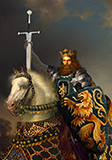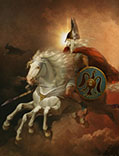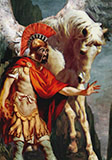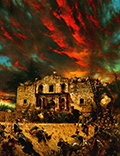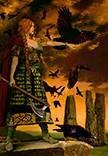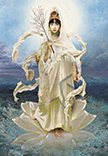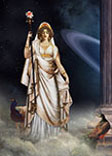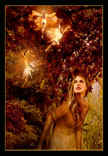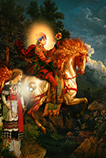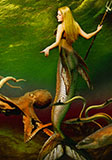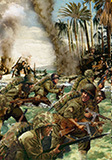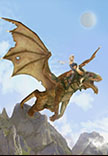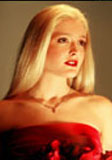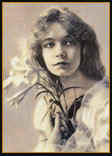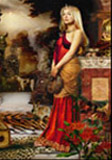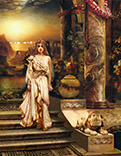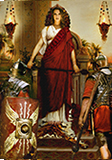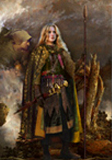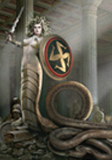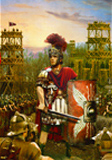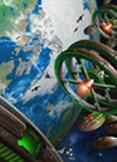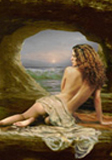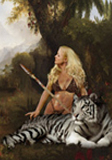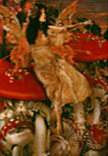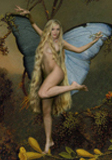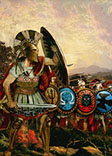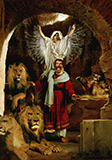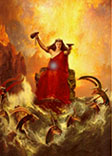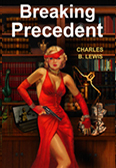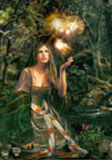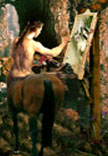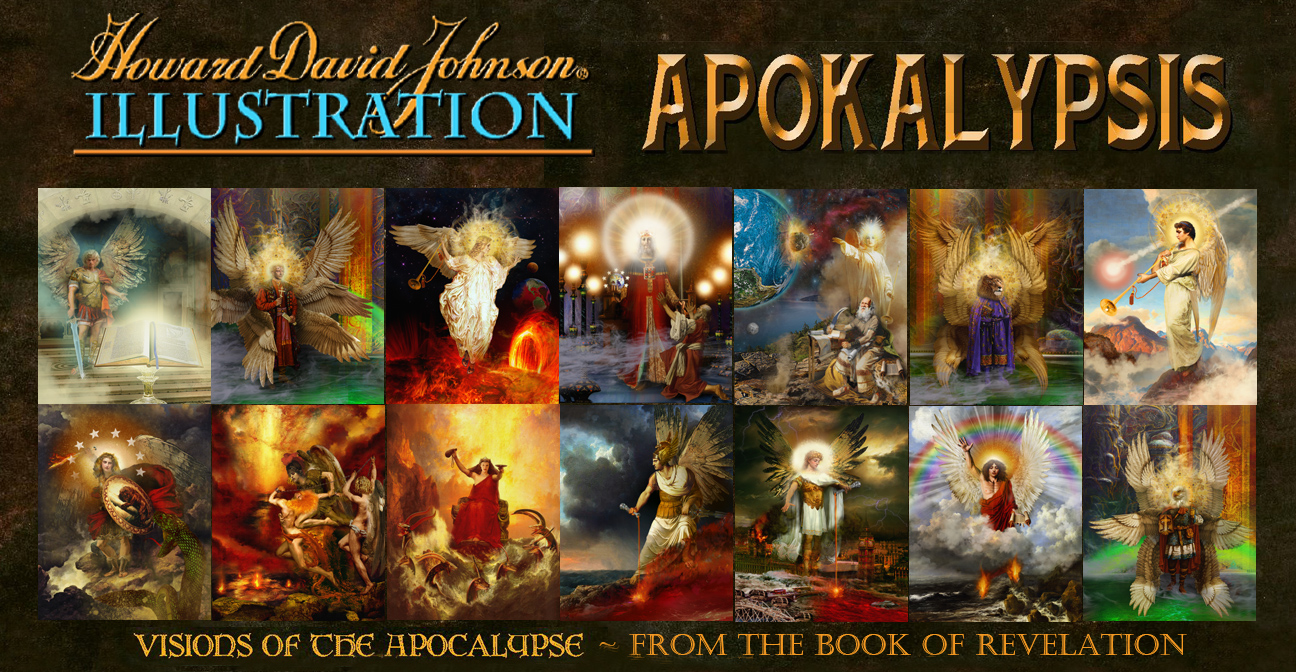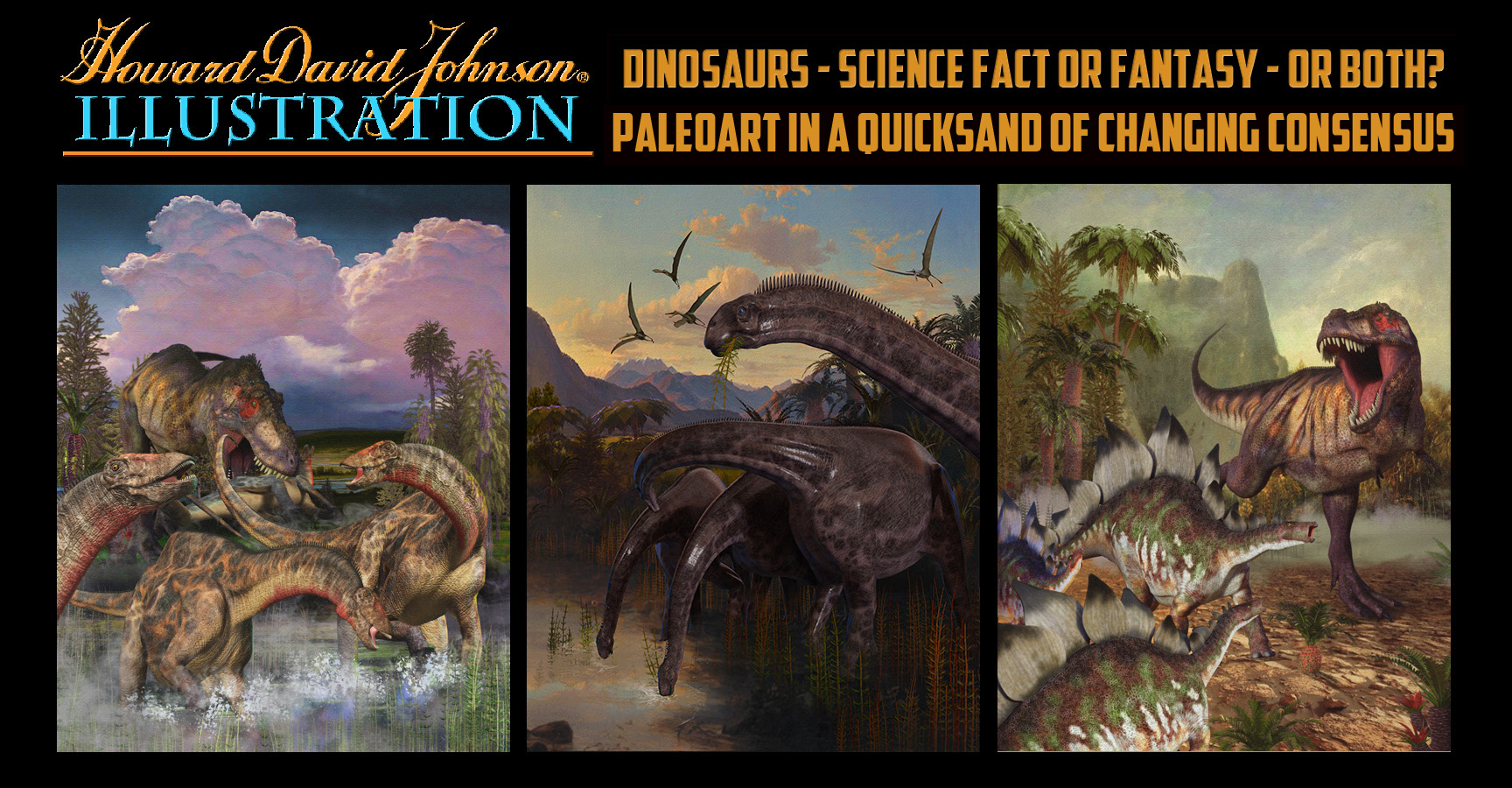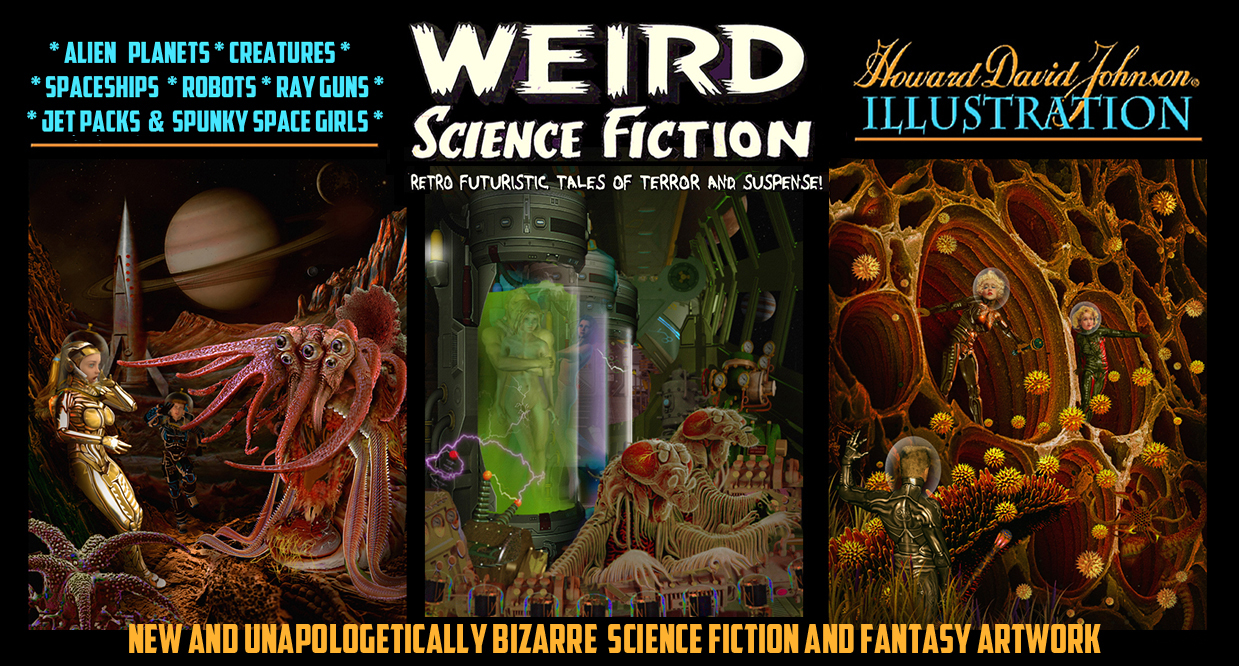Realistic Painting Style and Technique: A candid discussion and gallery with
essays on the issues
surrounding Realistic Painting from its early history to the present
by Contemporary American Artist and Photographer Howard David Johnson
whose illustrations of Mythology have been
published all over the world by distinguished learning institutions and
publishers including the Universities of Oxford and Cambridge. |
|

ALL HALLOWS EVE" MMIV
A traditional realistic Oil Painting rendered on Canvas. |

Presents: On Realistic Painting: An introduction to the schools of thought and
controversies surrounding realistic painting.
From the Secrets of the Old Masters to the Secrets of the New
Masters; A Gallery of New Paintings,
Drawings and Pictures in traditional oils,
Contemporary acrylics and cutting edge 2D & 3D digital mixed media in the style
of the classic illustrators. |

ATHENE, goddess of
wisdom and justice" MMV
A realistic oil
painting rendered on canvas. |
|
|
|
What EXACTLY is Realistic Painting?

("Pandora's
Box" MMV is another oil painting on 20 x 16 canvas and features
actor, model, and martial artist Kimber as the first woman from
Greek Mythology. |
The answer is not so simple
as you might think. With developments in Art and Technology a broader
definition than that which is found in common usage is now required, but
the traditional definitions were visionary and still apply:
"Painting, in art,
the action of
laying colour on a surface, or the representation of objects by this means. Considered one
of the fine arts"
~Encyclopaedia Britannica.
"Painting.
noun. 1.) The act or employment of laying on colors or paints. 2.) The art of forming
figures or objects in colors on canvas or any other surface, or the art of representing to
the eye by means of figures and colors any object; the work of an illustrator or painter.
3.) A picture; a likeness or resemblance in shape or colors. 4.) Colors laid on. 5.)
Delineation that raises a vivid image in the mind; as in word painting.
~
Webster's Unabridged Dictionary of the English Language.
The word Realistic means to apply Realism. Realism in Art and literature has always meant
that the artist attempts to represent persons, scenes, things, and facts as they are, life
as it is. The word is used in many senses- as opposed to romanticism, conventionalism,
sentimentalism, idealism and imaginative treatment but oddly enough, is often combined
with these. |
|
CONTROVERSIES
AND SECRETS SURROUNDING REALISTIC PAINTING:
The
world of painting has two major groupings; Abstract and Realistic
Painting. I love them both! The two major divisions of realistic
painting involve the application of mechanical aids such as
photography and the strict avoidance of them.
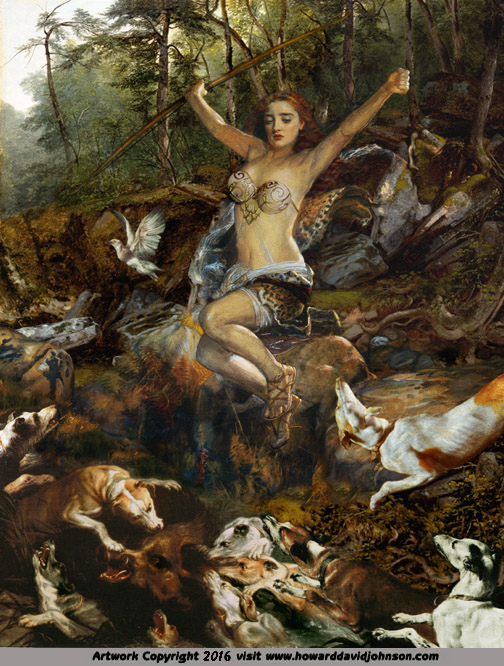
.jpg)
In the 1960's and 70's I was completely against them myself, but I love both styles
now! More often than not, professional artists use mechanical aids to please
difficult customers and meet unreasonable deadlines, while some hobbyists
feel the need to avoid the use of mechanical aids to prove their validity
as an artist. That's fine, hassling those who openly use them is not. Are
mechanical aids in themselves morally wrong?
Of
course not.
Did
you know the old masters often traced? Leonardo Da Vinci
used "Camera Obscura" which is a lens and a mirror set at
an angle with parchment over it to trace onto. Michaelangelo used a similar technique. |



Great Realistic
Painters began employing photography
as a
mechanical aid immediately after
it's invention in the 1800's.
This
is not surprising since artists had been tracing from Camera Obscura for
thousands of years.
Later artists like Maxfield Parrish would cut out and assemble
photographic collages to trace on boards or canvas and then paint. Even
later projection equipment lent more speed and control, but mechanical aids
could also create a dependence, stifling artist's creativity and imposing
limits. This has always been one the greatest pitfalls of creating realistic
paintings from photographs.
|
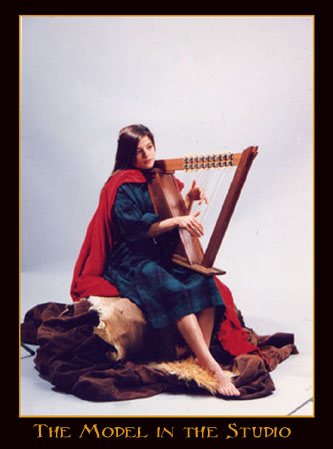
Analog Studio Photography
of Carmen provided a jumping off point. |
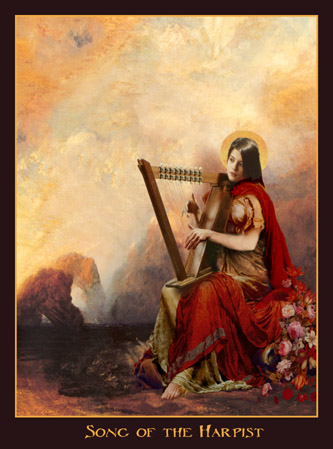
Song of the Harpist is a
digital painting created in the computer. |
Famous Myths; Leonardo
Da Vinci (1452- 1519 ) is often credited with the invention of Camera
Obscura because he used it for his masterworks during the Renaissance and
mentioned it in his notebooks, but this is simply not true. Similarly,
Americans are credited with the camera, but it is also not true. Unlike
the camera, the inventor and time of invention of Camera Obscura are
unknown. Perhaps it was known to the ancient Greeks, but there is no
evidence for this. The mathematical precision and perfect anatomy of Greek
art is enough evidence to convince many scholars. The earliest description
of Camera Obscura occurs in the great optical treatise Opticae Thesaurus (
Book of optics ) of the Islamic scientist Al-Hazen who died at Cairo,
Egypt in A.D. 1098. Since he says he did not invent it, we know it came
sooner.
|
|
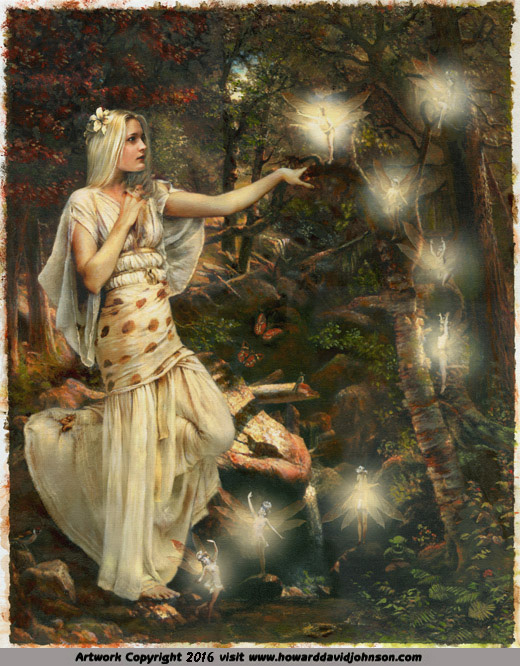
"Faerie Guardians" MMVI
is an oil painting on 20x16 canvas.
|

"Sleeping
Beauty" MMV is another oil painting this time on 11 x 14
Bristol board. |
|
"Circe the
Enchantress" (below left) from Greek Mythology, is rendered in Colored Pencil on
Windsor-Newton Cotman watercolor paper and is based on photographs taken
by the artist. In "Elven
Fairy Magic", (below Right) Elements of fantastic realism, surrealism and symbolism abound, especially in
the women's faces in the evaporating mist. In addition to theme and content,
being important to realistic painting, media is
an important issue- this is A Prismacolor "Painting" if you
will, because this is not the kind of picture people think of when they
hear the word "Drawing".
|

"Circe the
Enchantress" features a more daring pose and had to be censored. Prints of
the uncensored versions are available from our vendors.
|

"Elven
Fairy Magic" featuring Ann also
had to be censored due to outrageous double
standards about the female body being shown from the front view.
|
|

"We have had enough of kings" ~
George Washington |

"The Charge of
the Light Brigade"
|
|
"ALL HALLOWS
EVE" Here are examples of the same realistic fantasy illustration rendered in
digital media, as Prismacolor Painting, and as a painting on canvas using
manufactured tube oil paints
as opposed
to hand mixed paints. Tube paints were violently rejected by reactionaries who
forcefully proclaimed anyone who used paints from a tube was not a "real
artist". Well, tube paints are pretty well accepted now,
but
opposition to progress is still with us.
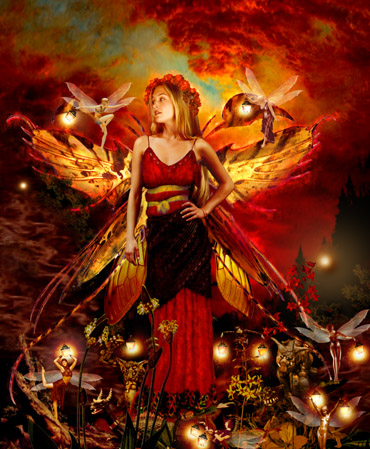 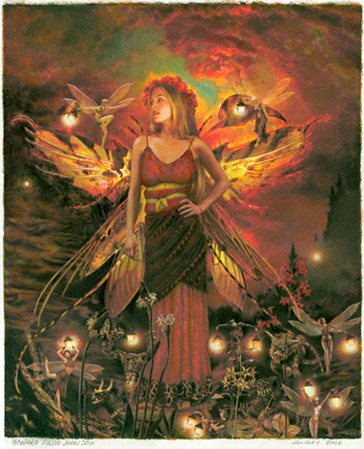 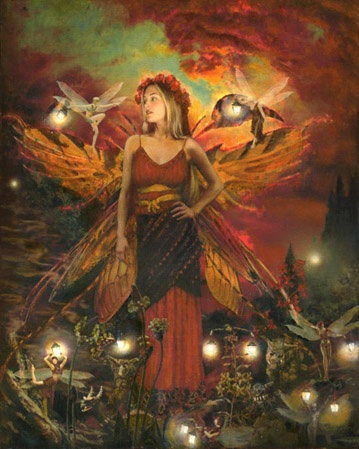
|
Mixed Media including digital |
Prismacolor
colored pencils on paper |
Oil Painting on
Canvas
|
There are
those who believe artists who use mechanical aids can't draw free hand and
demand artists all prove their talent first by drawing WITHOUT any
mechanical aids. I'm sure very few people from this camp have dealt with
demanding art directors or outrageous deadlines. These pencil drawings below and HUNDREDS of
others I did in the 1970's WITHOUT tracing settled this issue forever when I was a
teenager. I was against mechanical aids myself in those days, but when I found out
that ALL the artists I admired
most used ALL the mechanical aids at their disposal, I
started using them myself.
|
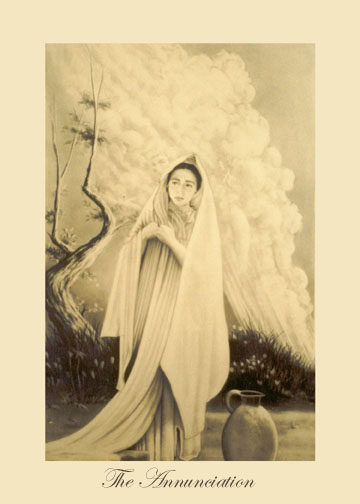 |
 |
|
"Jesus
walking on the Sea" Graphite 1978 was done without any mechanical
aids of any kind or reference whatsoever. Those of you who feel the need to judge my talent, just compare it with Michelangelo's work done at the same
age. My mission is not to prove my talent, but to preserve my heritage. I think talent is overrated and hard work is a hundred times more
important than talent when it comes to creating good art. I've known a lot
of talented people who were so lazy that hard workers with next to no talent
and a teachable spirit easily surpassed them. I firmly believe effort
exceeds talent. Talent is for amateur art contests. SPEED, ADAPTABILITY,
and RESULTS are for professionals.
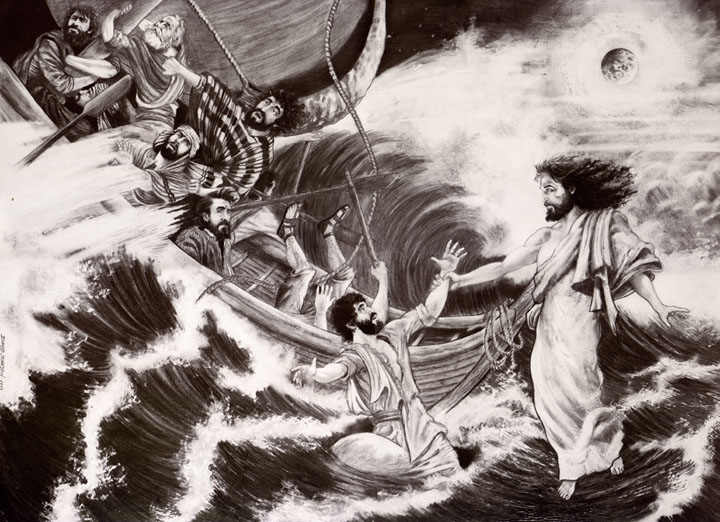
Realistic Paintings in Mixed Media:
"Return with your shield or on it" Was every Spartan woman's wartime
farewell... Not even a Spartan MOTHER could
forgive cowardice, the heavy shield made flight impossible and "Into
the Lake of Fire" MMX (Mixed Media) Of
course these works are in keeping with the Pre-Raphaelite tradition to do
religious and historical themes. This one is influenced by heavily by Delville,
and borrows from Bougereau and Leighton. It is an illustration from The Book of
Revelation Ch. 20: "The Dragon that old serpent, that is the Devil, cast in
the Lake of Fire"


"Return with
your shield or on it!" and "Into the Lake of Fire" are a new breed of
Realistic Painting in Mixed Media including digital
These digital
illustrations are created in a style to look a great deal like oil
paintings and cost customers a great deal less...
 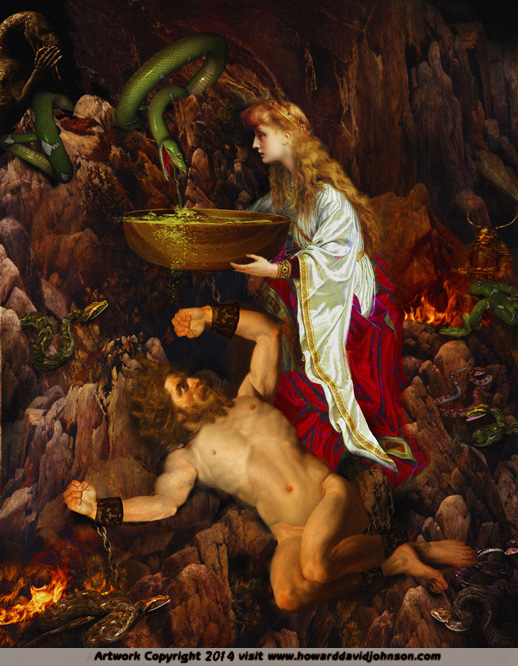 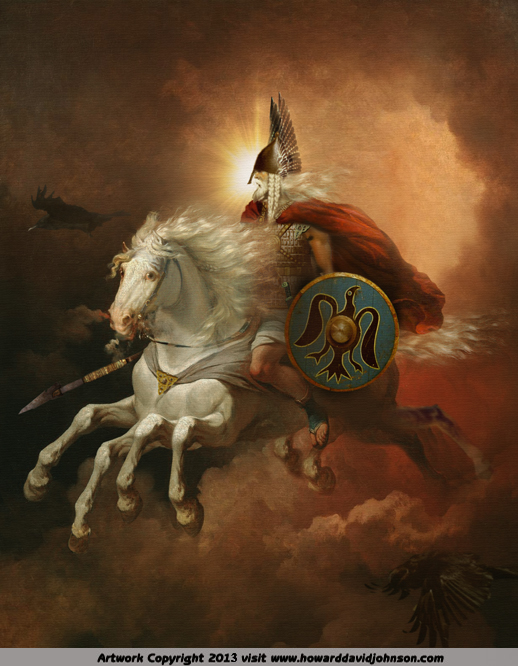
There
is a school of thought that seems to think that a caveman’s beating on a
hollow log with a stick is automatically superior to Beethoven’s Ninth
Symphony performed by the world’s finest symphony orchestra because less
technology is involved. I do not subscribe to this kind of thinking.
Personally I LOVE computers!
First of all, there’s the freedom from fear! The undo button is empowering
and liberating!
More importantly, publishing
customers can't afford to pay me for old-fashioned traditional methods like
oil on canvas. I can do them, and do them well, but no one but millionaire
art collectors can afford to pay even poverty level hourly rates for all
that time.

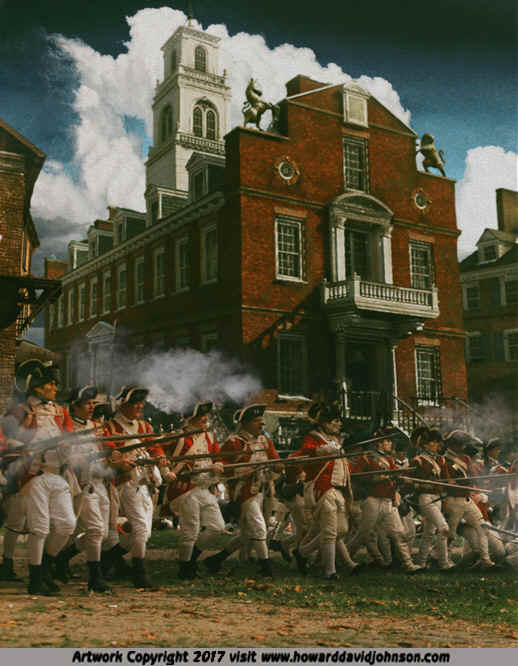

The masters often took a year or longer for a single painting. With digital
media I can create pieces that look very nice for very nice prices and with
blazing speed. The publishing industry is not noted for its patience. In the
early days of my art career, mailing traditional media originals was scary
at best, but now they can be scanned and shipped without risk.
Also in my early days adding canvas space to a work in progress was as
impossible as growing a second head... but now it is so easy I usually
don't even charge extra to adapt them if its just skies or landscapes!
Re-dos and revisions were financially catastrophic! No wonder the starving
artist became a stereotype! Now with the internet and its world wide
reach, an artist can actually earn a living from their work.
|


2005
version
2014
version
"Helen of Troy"
is my
loving tribute to my favorite Pre-Raphaelite, John William Waterhouse
and studies from his "Miriamne
at the Judgement seat of Herod"
"HELEN of TROY" MMV above left is a 'Prismacolor Painting'. These
relatively new soft oil and wax pencils are not the first Dry Painting Medium: the term
'Pastel Paintings' originated in the 17th century. These Paintings also employ the used of Prismacolors liquifed with solvents and applied with brush... To find out more about my pencil and colored pencil drawing techniques,
photographic studio techniques and digital methods visit my
how to draw in pencil or art instruction pages.


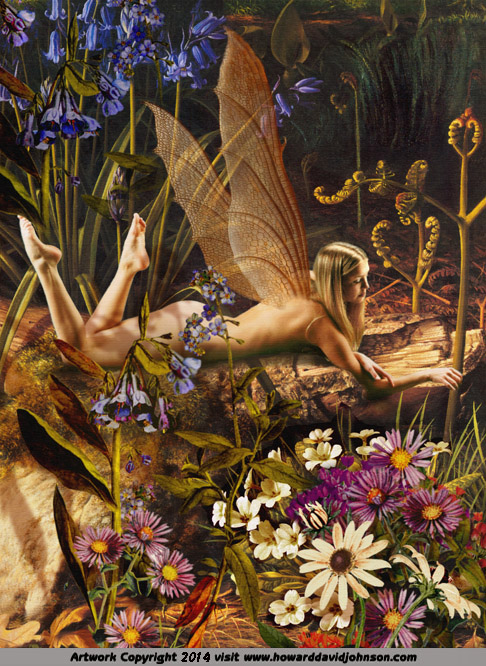
All these were created in Mixed Media including Oils,
acrylics, colored pencil, photography, 3D studio Max and Adobe Photoshop.


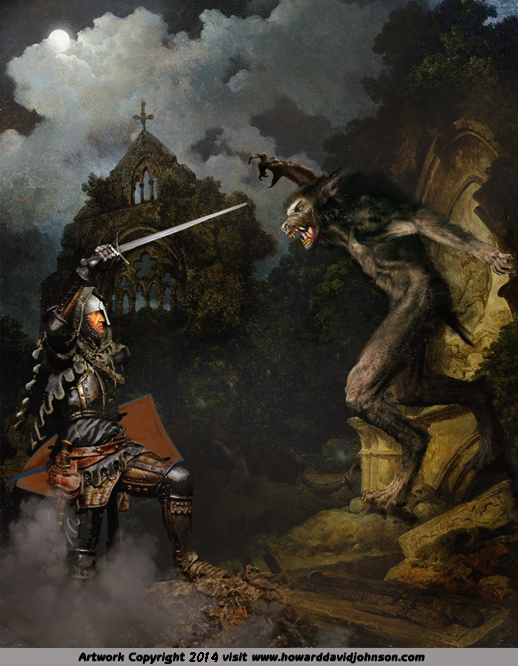
  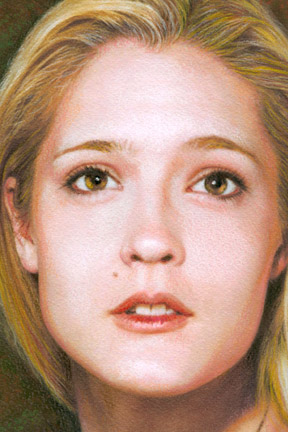
"Serious Instruction for
Serious Artists"
Who is
American Illustrator Howard David Johnson?
In one of David's invitations to the
Florence Biennale Contemporary Art Exhibition, (a partner in the United Nations'
Dialog among Nations), UN Secretary General Kofi Anon wrote him:
"Artists have a special role to play in the global struggle for peace. At their
best, artists speak not only to people; they speak for them. Art is a weapon
against ignorance and hatred and an agent of public awareness... Art opens new
doors for learning, understanding, and peace among nations."
|

A
portrait of the artist in his painting studio as he
is today in a photo taken by his youngest son Erich.
|
Howard
David Johnson is a contemporary visual artist and photographer with a
background in the natural sciences and history. He works in a wide
variety of media ranging from traditional oils, pastels and others
to cutting edge digital media. After a lifetime
of drawing and painting, Howard David Johnson's Traditional Realistic Art was exhibited in
the British Museum in London in 1996, ( 3 years before he got his first computer ) as well
as numerous American ones since, such as the Metropolitan Museum of Art. His illustrations
have appeared in every major bookstore and game-shop chain in America as well as magazines
and educational texts around the world. Some of his more
prestigious clients have included the National Geographic Society,
the University of Texas, the University of Cambridge in England, the
History Book of the Month Club, Adobe Photoshop Auto FX, Universal
Studios, Paramount Studios, and PBS TV.
Oil Paintings, Colored pencils, Pastels,
Mixed media, and Digital art can also be commissioned for select projects - Click on
commission new art below...
Working in a variety
of traditional and cutting edge digital media he offers his customers a variety of options
and more than thirty years of experience. As a commercial illustrator HDJ has not only
used the computer but has been involved in the development of imaging software.
On his existing works license offers start as
low as $99.
|
|
PIECES OF ORIGINAL
ART ON PAPER LIKE THESE ARE AVAILABLE:
Some pieces
are currently available, mostly 11x14-13x16 inch Prismacolor Paintings
(like Helen of Troy) and pencil portraits (like Arriba #2) followed in
number by Acrylic, Prismacolor and pastel mixed media all on #400
Strathmore Bristol Board ranging from $700.00-$1400. 00 USD and Oil
Paintings on canvas ranging from $1999.00 - 10,000.00 USD.
Pieces that have never been rendered in oil can be
commissioned in 16x20 inch size on canvas for 50% down and delivered in
under 90 days with signed certificates of authenticity aka legal documents
pledging never to render it in that size and media again to ensure premium
collectability and investment potential.
 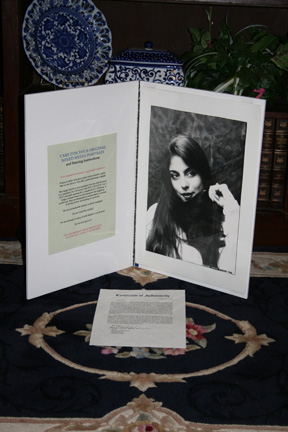 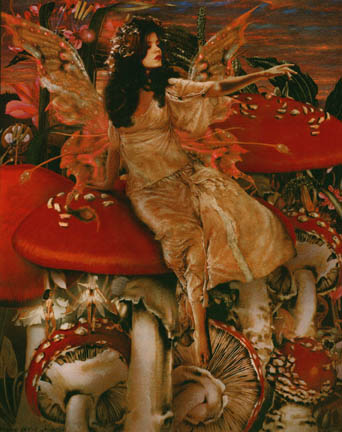
David can also do a completely new picture designed in digital media (for
more on this visit his digital media page) and when we approve the
photo-montage, he uses it as reference to render it in oil on canvas. No surprises.
Existing
Artwork is shipped very well protected and go out to you immediately
via Fed Ex or USPS Express mail upon receipt of payment at our
expense.
All
new creations cost a bit more depending on what is involved. All new
creations and rendering photo montages into art on paper are a LOT of fun with e-mail attachments and digital cameras.
ORIGINAL OIL PAINTINGS ON CANVAS LIKE THESE ARE ALSO AVAILABLE:
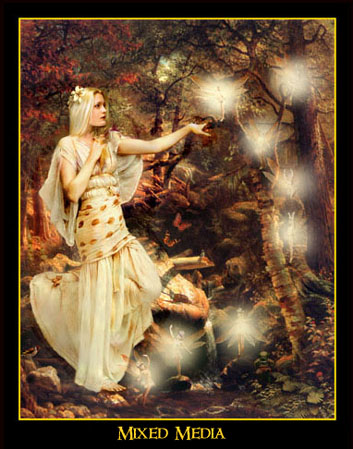 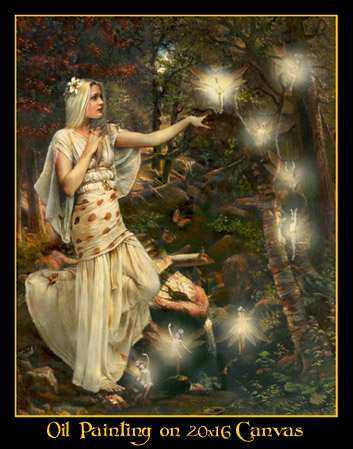 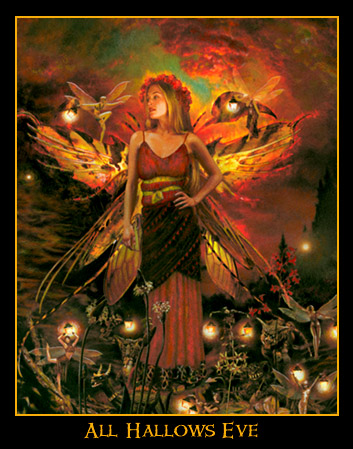
Almost
all of Johnson's Mixed Media creations (above left) are available to
be rendered in oil on canvas once like the 20x16 oil on canvas Faerie
Guardians (above right). Each design will only be rendered in oil
once at this size and can be delivered in as little as 90
days.
Sadly, much of the subtlety, vibrance, lustre and impact of an original oil
painting is lost when it is scanned and imported to digital media or even
printed by a master printer. Nothing can compare to an original oil painting
viewed in person in my opinion but the other painting media definitely look good
in print and have
their charms and distinct advantages. People have written asking me to tell them
how to tell mixed media from prismacolors or oil. The very fact it is so hard to
tell is my point! This new media looks very presentable and costs far less! ALL
HALLOWS EVE was begun as a digital montage This is your guide: above far right
is the digital composition...The question is, are you willing to pay tens of
thousands to be old fashioned if only an art expert can tell the difference?

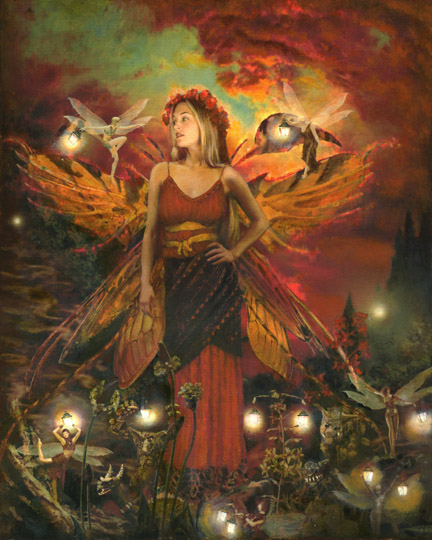
ALL HALLOWS EVE rendered in oil on 20x16 canvas (right) features
Ann as Titania in this illustration from Shakespeare's
Midsummer Night's Dream. Even when displayed at the same size the oil on
canvas is clearly a superior illustration to the 2006 Prismacolor Painting
on paper. (left). Considering many oil painters charge 60,000.00 USD and
up my 2,000.00 USD prices are very low...
e-mail for
more details at
info@howarddavidjohnson.com






Thank
you for Visiting... Your business,
letters, & links are always welcome.
*****
|
|
|
This Gallery
has been
honored by more than 35,000,000
Unique Visitors
from the
Four
Corners of the Earth
My
Friends from around the world thus far :
England, Canada,
Scotland, Wales, Ireland, Germany, France,
Monaco, Andorra, Italy, The Vatican City State,
Greece, Macedonia, Cyprus, Turkey, Belgium, Denmark,
The Faroe Islands, Greenland, Yugoslavia, Macedonia, Croatia, The
Czech Republic, Bosnia, Herzegovina, Slovakia, Slovenia,
Luxembourg, Latvia, Estonia, Hungary, Bulgaria,
Lithuania, Poland, Austria, Romania, Spain, The Russian
Federation, Estonia, Ukraine, Kazakhstan, Moldova, Malta,
Iceland, Finland, Norway, Netherlands, Switzerland,
Liechtenstein, Sweden, Portugal, Albania, Armenia, Georgia,
Slovak Republic, Azerbaijan, Belarus, Kazakhstan,
Gibraltar, Israel, Palestinian Territories, Egypt,
Libya, Mali, Algeria, Niger, Saudi Arabia,
Oman, The United Arab Emirates, Kuwait, Bahrain, Qatar, Yemen,
Iraq, Iran, Jordan, Syria, Lebanon, Morocco,
Ethiopia, Eritrea, Liberia, The Republic of
Congo, Rwanda, Kenya, Angola, Ghana, The
Ivory Coast, Zambia, Zimbabwe, Sudan, Nigeria,
Namibia, Sudan, Uganda, Kenya, Eritrea, Tanzania,
Botswana, Malawi, Senegal, Djibouti, Cameroon, Chad,
Gambia, Mozambique, Swaziland, Lesotho, South Africa,
Seychelles, Viet Nam, Japan, South Korea, China, Hong
Kong, Macau, Mongolia, Mauritius, Singapore, Thailand,
Cambodia, Laos, Myanmar,
Macau, Malaysia, Taiwan, Nuie, New Zealand, Fiji,
Cook Islands, New Caledonia, Vanuatu, American Samoa, Australia,
Micronesia, Polynesia, Papua New Guinea, The Heard and McDonald Islands,
The Philippines, Guam, Palau, Cocos Island, The Kingdom of Tonga,
Malaysia, Brunei Darussalam, India, Pakistan, Afghanistan, Bhutan,
Bangladesh, Sri Lanka, Chagos Islands, The Republic of Maldives,
Turkmenistan, Kyrgyzstan, Uzbekistan, Tajikistan,
Azerbaijan, Nepal, Indonesia, Chile, Argentina,
Uruguay, Paraguay, Brazil, Peru, Aruba,
Venezuela, Bolivia, Suriname, Guyana, Aruba, The
Dominican Republic, Guatemala, Costa Rica, Colombia, Trinidad
and Tobago, Antigua and Barbuda, Barbados, The Virgin Islands,
Saint Lucia, The Netherlands Antilles, Panama,
Northern Mariana Islands, Saint Vincent & Grenadines, Grenada, Ecuador,
Belize, Nicaragua, El Salvador, Bermuda, Cuba,
Jamaica, Dominica, Haiti, Puerto Rico, Cayman Islands, The Bahamas, Honduras, Mexico,
Madagascar, Central African Republic, Ethiopia, Gabon,
San Marino, Saint Kitts & Nevis Anguilla, Burkina Faso,
Equatorial Guinea, Polynesia, Madagascar, Mauritania, Burundi, and my home, The Great Free State of
Idaho (USA)...
If your home is not listed here please
e-mail and tell us where you're from...
info@howarddavidjohnson.com
Your business,
letters and links are always welcome!
|






|

Gorgeous Quality
Printing
Hand Signed &
Numbered
Free Shipping
Worldwide

|

LIMITED EDITION
[of a maximum 1,000
prints per image]
PRINT-ON-DEMAND
Each inspected, hand
signed and numbered by the artist!
CLICK
HERE
TO BROWSE OVER
400 CHOICES
CHECK OUT FAST AND
SECURE WITH
PAYPAL!

thejohnsongalleries@gmail.com
Sized to fit
standard sized frames!

ASK ABOUT GIFT CERTIFICATES
|

The Johnson Galleries
prints these "in-house" with our new state of the art Epson
7890 oversize printer on
Epson 200 year premium photo paper and canvas with Epson inks!

|
Essay
and Article Section:
Philosophy,
Art, & Art Philosophy
Personal Opinion
Essays on Realism yesterday and today by the artist.
|
Art and
Technology:
From the Camera to the Computer
A brief overview of the shifting cultural attitudes toward
Realistic Art in the last 150 years
~Essay #8 by Howard David Johnson
The first decade of the 21st Century has seen
a grass-roots counter-revolution in the art world which has
overthrown the stranglehold elitist proponents of Abstract
expressionism gained on academia, the media and the art
world at large in the early 20th Century.
Realistic Art was declared obsolete and irrelevant at the
beginning of the 20th Century due to the easy
chronicling of persons, places, and events by the Camera -
in spite of this new technology empowering the greatest era
in Realistic Art history. The “Modern Day Artist” refused to
die and began to explore realms of the heart and mind the
camera could not record. The proponents of Abstract
Expressionism gained control of elite art collector’s
markets followed by academic institutions and the media
leading to the abandonment of centuries of classical
teaching methods and traditions in our universities. Even
the best realistic art was later denounced and ridiculed as
the dismissive and often even hostile Art establishment
created elitist scorn for Realistic Art in general. This
created a disconnect with the general population who could
not relate to the tenets of Abstract Expressionism. The
advent of the internet broke the absolute domination of the
opinions of the Abstract School on media and academia and
opened the floodgates of artistic expression and free
opinions. Free at last from institutionalized condemnation,
more and more artists began to choose realistic treatments
and a tidal wave of fabulous new realistic art has been
created in every conceivable visual art media for museums,
galleries, books, movies, and video games.
As the camera became commercially available in the early 19th
Century it became clear that the visual artist was no longer
an indispensable member of society. Just about anyone could
point and shoot this device at persons, places, and things
and get very fast and very realistic results. Resentment
from thousands of years of artists’ social and political
influence fueled the notion that visual artists should be
declared obsolete. The adoption of the camera as an artist’s
tool and the advent of an era of glorious and unprecedented
realism in painting did not stop the movement to crush the
political and social influence of the artist.
Great realistic artists like Pablo Picasso and others like
Vincent Van Gogh courageously answered this challenge by
exploring concepts that could not be photographed with
brilliant and visionary works. It was from these honest and
ingenious notions that the schools and sub-schools of
Abstract Art developed. The freshness and innovation of this
movement took the art world and academia by storm. The
excitement of defining the tenets and the delight of
bewildering the masses gave rise to an elite class of
critics who could control the lucrative art collector’s
market with obfuscation and intellectual snobbery.
This wealthy art collector’s market gave credence to
Abstract Expressionism’s “high art” status and the advice of
well placed critics became extremely valuable and they
formed an alliance with like-minded academics. As time
passed, this trendy movement whose concepts were so hard to
argue with gained control of the establishment and elitism
took root. It was not long before traditional painting
methods were not taught in universities any more as
realistic art was no longer considered “Real Art” and tenets
like; “Art must be ugly”, Art must be new” Art must be
obscure”, and “The best Art is offensive” took hold in
schools and printed media.
Not satisfied with control over the
most lucrative galleries, collector’s markets and academia,
these elitists moved from dismissive to openly hostile
attitudes toward those who still loved and created realistic
art. The merciless and unprovoked rebukes of great realistic
artists like Norman Rockwell, N.C. Wyeth and so many others
are well documented in 20th century histories.
That’s not “Real Art” and why do you waste your talent on
“Mere Illustration” were some of the nicer comments.
Illustrators in the 20th century wore these
rebukes like badges of honor, like black eyes gained from
standing up to schoolyard bullies, knowing in their hearts
what they were doing was worthwhile and the narrow minded
views of their critics were not the only valid opinions. By
the end of the 20th century, the long
apprenticeship tradition was broken and classical realistic
art methods were lost forever. The Shock Art movement in the
1990’s carried the tenets to new extremes as “ART” became a
dirty word. U.S. Government Endowments for the Arts were
discontinued. Abstract Art had become the norm with its
obfuscated themes and was then itself considered irrelevant
and academically worthless. Art programs were then removed
from countless public school curriculums to make time for
standardized test preparation.
There is no way that mandating
more math, requiring more reading, or scheduling more
science will replace what we have lost as a culture.
At the turn of the 21st Century the Abstract
Expressionists had been in control for generations with a
thought control blockade in books, newspapers, radio,
television and schools. Anyone who disagreed with them was
told they were too stupid to understand “Real Art” and
theirs was the only voice to be heard. What had begun so
beautifully and sincerely was hijacked and violated until it
became a byword for vulgarity. Then came the internet and
the realistic artists, long silenced began to express their
views. It was like the boy who cried: “The Emperor has no
clothes!” This revelation spread like wildfire through
the cultural consciousness. Suddenly, it was no
longer a disgrace to hold something other than those narrow
views. Galleries on the internet showcased generations of
repressed artists realistic works in a tidal wave art
history calls: “the Realistic Revolt”. Of course, Abstract
Art still flourishes today especially on college campuses,
but the narrow views of its most fanatical proponents are no
longer cruelly dominant.
The Realistic Revolt has brought the return of
respectability to illustration and realistic landscape and
portraiture. When I see the works of today’s vast multitude
of realistic artists coming from a thousand different
directions at once, tears come to my eyes, for I have worn
the title “illustrator” as a badge of honor for decades and
am deeply moved to have lived to see new developments in art
and technology drive the visual arts to levels of quality
beyond my wildest dreams. I predict 3D and digital media
will grow more and more realistic until photos seem
noticeably inferior. The internet has not only opened the
floodgates for artistic expression, but employment and
untold artists are earning a living shattering the “Starving
Artist” stereotype so engrained in our cultural
consciousness. The beginning of the 20th century
saw technology threatening the survival of the professional
artist and the end of it saw the unbridled tenets of
Abstract Expressionism like “Art must be offensive”
threatening the very existence of art as a part of our
culture, the modern day artist has once again refused to die
and has embraced technology to create a rebirth of realism
that Art critics, collectors, academics and everyday folk
can all embrace and celebrate in ways I once feared had been
lost to us forever.
~ Howard David Johnson (2012)
|
|
Essay Seven:
On Art and Technology:
When Seeing is Not Believing
An essay dealing with mechanical
aids to visual art from Camera Obscura to Computers
Howard
David Johnson is an outspoken proponent of mechanical aids to visual
art. Unlike the opponents of mechanical aids, his mission is not to
prove his talent but to help preserve our vanishing Western cultural
heritage. In addition to his mastery of the traditional media, now
combines drawing, painting, photography, and digital media with more
than thirty years of experience in these fields to create his
Realistic Art Numerica in 21st century paintings and pictures.
Did you know the
Greek word "Photography" means "Painting with
Light"? Today with the advent of computers it truly lives up to
it's name. Due to developments in Art and Technology, a broader
definition of painting is needed than that which is found in common
usage.
Introducing
Art Numerica- an exciting merger of traditional visual art and
cutting edge technology... a new art form for the twenty- first
century... Art Numerica is not limited to realistic art but also
offers limitless horizons for everything from cartoons to
abstractions.
It
is the most dramatic development in the visual arts since the
Renaissance.
|
|
When the
camera was finally made commercially available in the 1830's it exploded on the world
scene and sent shockwaves through the art world as history had never seen before. Visual
artists all over the world were suddenly put out of work and resentment and outrage
followed. Suddenly much more realistic portraits could be had at a tiny fraction of the
cost of a painting and delivered almost instantly. The art world would never be the same.
When motion picture cameras were new, seeing was believing and human consciousness changed
forever in the 20th century. Sometimes even Terror and Panic came from the initial shock!
In 1905 cinema patrons defecated and urinated in their seats as they broke each other's
arms and legs desperately fleeing for their lives from a crowded theater to escape a train
charging straight for them! ... train footage filmed safely from a bridge with a camera
lowered down on a rope. A modern cinema patron would not even feel uncomfortable. The
Photograph and its manipulations have changed human consciousness and history... and will
continue to do so in the future.
The Camera has changed everything.
The Camera of Today owes
it's origin to the Camera Obscura, a light- tight box with a lense and a screen that
receives an image. This device has been used by artists since ancient times to trace the
projected image of whatever they set before it on a screen. Intrigued by the idea of
producing a permanent light-formed image instead of reproducing it by hand, a long line of
inventors studied the problem and successively made contributions to the solution.
Photography was neither
discovered nor invented by any one man. It was the outcome of the early observations of
the alchemists and chemists on the action of light, a subject that belongs strictly to the
domain of photochemistry. Although the blackening of silver salts was known in 1565, it
was not until 1727, when Johann Heinrich Shulze of Germany used a mixture of silver
nitrate and chalk under stenciled letters, that it was definitely recognized that this
darkening action was caused by light and not by heat. In the years that followed
experiments with silver nitrate on leather and wood were successful. In 1817 J. Nicephore
Niepce first tried photography with silver nitrate and paper. In 1826, L.J.M. Daguerre, a
painter who had experimented with silver salts approached him and formed a partnership.
Daguerre discovered
accidentally that that the effect produced by exposing an iodized silver plate in a camera
would result in an image if the plate were fumed with mercury vapor. The Daguerreotype
process was a complete success. These chemical processes would be improved again and again
until the advent of the digital camera we know today. The attitude that Photography
was not art and was a purely mechanical process requiring no talent whatsoever was put
forth with great force and hostility in an attempt to get people to refrain from choosing
it for their portraits instead of paintings. This is a typical reaction to new technology,
when Pastels were first invented they were dismissed as a child’s plaything rather
than a viable art medium. These attacks on new technology are not limited to the arts of
course. When the Wright brothers were making history at Kitty hawk with the first manned
airplane their detractors said: "If man were meant to fly, he'd have been born with
wings." This kind of negativity is just human nature to some kinds of people.
Photography came into being through an
artistic, not a scientific urge. Daguerre was an artist, a scene painter whose
illusionistic diorama was a landmark in Paris long before his name was connected with
photography. Critics were merciless as usual, with scathing condemnations of the media.
However, in the hands of a sensitive artist, photography quickly showed it's artistic
possibilities. David Octavious Hill, a Scottish Painter invented the camera set up and the
pose as we know them today in the 1840's and was the first of a new breed of master
photographic artists. Photography was here to stay. Diverse forms of retouching techniques
followed both by accident and by design and took the medium to new levels of artistic
excellence. Now, more than a century and a half later only an uneducated or blindly
hateful person would say Photography is not an art form. Of course we've all seen our
share of awful pictures with the heads cut off taken by amateur photographers but we've
also seen the work of studio masters like the great portrait photographers from Hollywood
in the 1930's and forties. Anyone who has tried to create such a sophisticated studio
photograph realizes quickly that this is a very difficult art form to master even if a
trained orangutan can take a bad snapshot with an instant camera made for children.
The use of Photography as a mechanical aid to
traditional oil paintings and other forms of realistic art came right away. This is not
surprising since artists had been tracing from Camera Obscura for thousands of years.
Famous Myths; Leonardo Da Vinci ( 1452-1519 ) is often credited with the invention of
Camera Obscura because he used it for his masterworks during the Renaissance and mentioned
it in his notebooks, but this is simply not true. Similarly, Americans are credited with
the camera, but it is also not true. Origins: Unlike the camera, the inventor and time of
invention of Camera Obscura are unknown. Perhaps a crude form of it was known to the
ancient Greeks, but there is no material evidence to substantiate such a point of view.
The mathematical precision and perfect anatomy of Greek art combined with their passionate
love of science and mathematics is testimony enough for many scholars. The earliest clear
description of Camera Obscura occurs in the great optical treatise of the Islamic
scientist Al-Hazen who died at Cairo, Egypt in A.D. 1098. His Opticae Thesaurus ( Book of
optics ) was rendered into Latin sometime during the 12th or 13th century by an unknown
translator. Al- Hazen honestly declares that he himself did not discover it, so we know
from this it had to have been masterminded before A.D. 1098.
| Camera
obscura is a device for tracing or sketching large objects. It consists of a box painted
black inside- a mirror at a 45 degree angle , and a lens, like that used in a
photographic camera. An image is thrown on the mirror by the lens and reflected on the
screen, where it can be sketched with tracing paper. The Camera Obscura was in general use
by newspaper and magazine il! lustrators until it was replaced by the photographic camera.
Make no mistake. Professionals have been using mechanical aids since the first caveman
shaman traced his hand out on the wall of his cave. The view finder on the reflex camera
is a development from Camera Obscura. Camera obscura, interestingly enough, is Latin for
"darkened chamber".
In
the early 1600's the telescope came into use and Camera Obscura spared viewers the harmful
effects of gazing directly into the sun. I regret, but that we must acknowledge the fact
that almost every art medium throughout the ages has been corrupted. In the 2nd century,
the Roman emperor Hadrian had the head of his lunatic predecessor Nero removed from a
statue and replaced by that of his favorite. Much later in 1539, Holbein painted a
glamorous and flattering portrait of Anne of Cleves for Henry VIII. When the future queen
arrived in England, King Henry met the surprisingly less than dazzling and glamorous Anne.
His disappointment made history. Our modern society certainly can't claim t he honor nor
take the blame of being the first to manipulate art forms.
|
 |
By the 21st century instead of the traditional assistants and apprentices, artists
employed overhead transparency projectors, opaque projectors, artographs, light tables,
slide projectors, color photocopying... and suddenly, computers and image editing
software, which brings us to some very compelling controversies regarding these modern
imaging technologies and their impact on various media and further changes to human
consciousness. For example: The integrity of Photography as evidence in our courts of law
stood for many decades until it was shattered by the digital manipulation of photographs
and new standards needed to be introduced. Websites sold peeks at photos of
celebrities' heads pasted onto photos of wild women in scandalous poses for all the world
to see- but advertised as real celebrity pix. Scandal rocked television and other news
media when digitally altered photographs were being passed off as reliable evidence of
important news stories...
On a positive
note, no one was threatened by how this technology enabled motion pictures to do epic
things they could only dream of before. They were supposed to be make-believe images
appearing real! A golden era in special effects cinema ensued. Then, this powerful digital
imaging technology, like the camera, fell into the hands of the common man through
computer programs like Adobe Photoshop. A new culture of skepticism had abandoned the age
old adage; "seeing is believing" Photography has never told the whole truth,
just parts of it. Photography is also an art form and therefore rightfully susceptible to
creative alterations. In addition, the advancement of digital manipulation technology
cannot be undone or halted. I believe that we must recognize that this digital technology
exists on a gigantic-scale, and will never go away. Therefore, I suggest that digitally
altered photos are distinct from traditional photography, and should be treated as such.
Contrasting views: anti-manipulation
advocates’ fear a negative impact of digital manipulation in a court of law, and
pro-manipulation advocates say that we must wake up to the fact that for for decades
pictures have not been reliable evidence in court and that any good lawyer will attempt to
discredit photographic evidence. In response to claims that photos should always tell the
truth, the pro-manipulation camp would say that photos have never told the unvarnished
truth. A camera shows, and has always only shown, a fraction of reality, and even then
what we see is taken out of context or even fabricated. Photography from its onset has
been subjected to modifications. In 1839, the Frenchman Louis-Jacques Daguerre patented
the daguerreotype, or what could be called the first "picture." Simply
explained, the daguerreotype combined the usage of the camera obscura and silver iodide to
produce a permanent image on a copper plate. A very exciting innovation, Daguerre boasted
of it, "With this technique, without any knowledge of chemistry or physics, one will
be able to make in a few minutes the most detailed views" ("Photography").
Almost immediately, the daguerreotype, especially daguerreotype portraits, became
immensely popular. Its popularity, of course, can be attributed to its novelty, but also
because people believed the daguerreotype produced a more real image than a painting. The
general attitude toward the daguerreotype was that it could create images more
realistically because there was no artist to interpret and modify it in his own style.
Opponents
of Digital Manipulation insist Photography should always represent the truth, asserting
Photography's first and foremost function is to portray reality. Many assume that
photographs have never been manipulated, and that this recent outbreak in digital
technology damages the integrity of photography. Without delay, anti-manipulation
proponents demanded an end to all "dishonest" photography, as it severely
misleads the public. Also, they view digital manipulation as a purely mechanical process,
with no talent or skill involved. Furthermore, anti-manipulation proponents fear
manipulated photos might acquit murderers or rapists in courts of law. The thought that
photography had replaced painting abounded. "As if photography needed to absolve
itself from its ‘original sin’--of having brought about the death of
painting", a movement known as pictorialism thrived around 1890-1914, the Art Nouveau
period. Proponents of pictorialism primarily set out to gain the recognition of
photography as an art rather than just a mechanical process. The pictorialists fashioned
bizarre and oddly focused images in order to prove photography was indeed a creative art.
It was here that such concepts as shading and enhancing during development appeared.
Because of these new shadings and angles, it can be said that Art Nouveau saw the dawn of
"Photo manipulation." So the manipulation of photography actually began early in
the the 20th century.
In
1982 there was outrage over the manipulation of the Great Pyramids on the cover of
National Geographic but the Genie was out of the bottle. There was no going back. In the
1990’s Computer programs like Adobe Photoshop began to be available to the general
public. Now, even someone with little or no talent could produce delightful works. On the
other hand, sensitive artists could produce masterpieces on a scale undreamed of. It seems
clear that using this technology to willfully falsify photographs for slanderous,
scandalous, or persuasive ends is morally wrong, but what about using it to create obvious
unreality that looks real or Fantastical Realism in art as in pictures of fairies or
mythic creatures?
What is realism? Realism in Art and
literature has always meant that the artist attempts to represent persons, scenes, things,
and facts as they are, life as it is. The word is used in many senses- as opposed to
romanticism, to conventionalism, to sentimentalism, to idealism and to imaginative
treatment. Sometimes it is a term of praise, and sometimes it is a term of derision.
During the 19th and 20th centuries the use of the word realism often implied that the
details brought out were of an unpleasant, sordid, obscene, or generally offensive
character. Even the greatest illustrators of the day were ridiculed. Realism is commonly
applied to a 19th century school of writers and artists; but realism, in it's prime and
proper sense, is as old as art and literature themselves, but in the hands of it's most
notorious exponents, it quickly degenerated into a connotation of the more sinister
features of realism.
Many 20th century contemporary realists and artists working in the Photo Realism style
were trained in an educational system openly hostile or dismissive to Classical realism
and art tradition and were only taught the tenets of Abstraction and Expressionism. As a
result many of these artists are more akin to the abstract and expressionist schools than
the "Classical Realism" of the ancient Greeks, which adored beauty and nature.
Contemporary Realism does not embrace the math and design of the Classical school but does
not frown on beauty. Photo Realism only strives to look as much like a photograph as
possible and sometimes the results are shocking or disturbing. Other times they are
mundane and so ordinary as to be boring. They often deliberately decline to select
subjects from the natural, beautiful, and harmonious and more especially, depict ugly
things and bring out details of an unsavory sort for social and political purposes. The
real mission of Photo-realism is not to record everyday life like a Norman Rockwell
painting, but to expose the unconscious way we look at and accept photographs.
By the 20th century realism had spread to
nearly all nations- realistic elements combined with those of Impressionism, Symbolism,
and other movements. Fantastic Realism on the other hand, is born of these movements and
tied to them in style and technique, but prefers to explore subjects that are strange or
strikingly unusual rather than scenes of everyday life or objects. It is often bizarre in
form, conception and appearance and even wondrous in its beauty. Sometimes macabre and
grotesque, it is rarely boring like the other forms of Realism in visual art so often are.
Fantastic Realism can be completely apart from reality, yet appearing to be quite real. It
is versatile in that it can combine with or be a part of the Classical, Contemporary or
Photo-realistic schools or stand as a style unique unto itself. I combine elements from
all of these schools of Realism and then take it a step further by also combining a wide
variety of media from traditional oil paintings to today's cutting edge digital media in
my exhibits. Naturally, the darker side human nature shows itself again with condemnation
of new schools of expression, and new art media and technology. Like the photographers
before them, digital artists wanted the recognition of their work as an art rather than
just a mechanical process. Unlike the snapshot camera or an abstract painting, a trained
chimp or orangutan cannot do it: it takes the same visionary and eye to hand skills as any
traditional art media to do it well.
Since the times of the ancient
Greeks, Art History records a relentless quest for Realism and artistic excellence. The
masters of each generation strove to perfect their craft, then passed on the torch of
their accumulated knowledge and skill to the next generation.
The accomplishments and technological
breakthroughs of one generation have often set new standards of excellence for the next.
~ Howard David Johnson MMIV
*****
More Personal Opinion Essays on Realistic
Art yesterday and today by the artist.
In addition to his mastery of
traditional media, Howard David Johnson now combines more than thirty years of
experience in drawing, painting, photography, and now digital media to create
his Realistic Art in 21st century paintings and pictures.
Did you know the Greek word
"Photography" means "Painting with Light"? Today with the advent of
computers it truly lives up to it's name. It is the most dramatic
development in the visual arts since the Renaissance.
Essay One: "THE MORE THINGS CHANGE, THE MORE THEY STAY THE SAME..."
(A Brief essay dealing with attitudes toward Traditional Realistic
Paintings, Pastels, Colored Pencils and Art Numérica) |
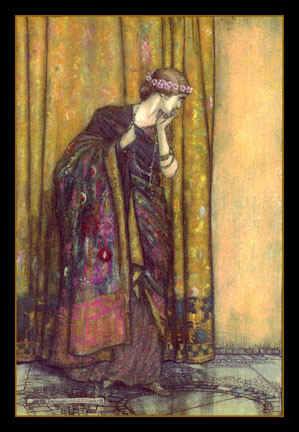 Pastel, Acrylics, and Colored Pencils combined |
Snobbism in the arts is nothing new. Some people will tell
you that oils are the only valid medium for realistic painting. That Colored Pencil,
Digital, and other Realistic Painting and Drawing Media are not valid for
"real" art. Young artists, Don't let them bother you. Their forerunners used to
condemn Pastels before they gained acceptance and called them "crayons" when
Johann Alexander Thiele (1685-1752) invented them. Mercilessly disrespectful
art critics of the time could not stop the Experimentalists no matter how
viciously they
attacked and derided them. "Crayon-painting" as it was called in England was
practiced early on by persecuted pioneers in Switzerland and many other nations. What a
debt we owe to these master artists who refused to knuckle under to the pressure of those
short-sighted critics during those historic and experimental times. It took until 1870
with the founding of the "Societe` Des Pastellistes" in France that respect
came at last to these heroic & immortal visual artists. |
In England the liberation of the Pastellists from slight regard and
undeserved disrespect came with the first exhibition of "The Pastel Society" at
the Grosvenor Gallery in 1880. Pastel Painters like Mary Cassat and others from
America and other nations forever silenced the snobs with their masterworks and
gained recognition at long last for Thiele's invention as a valid art medium. I am
persuaded that history will repeat itself. Like Pastels, I believe these wonderful
new colored pencils and even Digital Realistic Art Media will one day
receive the
recognition they deserve as powerful mediums of artistic expression just as pastel
paintings did. What is your definition of art? Have you thought about it?
Mine is: "anything that
makes you feel or think."
Consider
dancing... it can be a little skip in the step or rise to the level of the incomparable
Russian Ballet. Did you know that just the materials alone for a single oil painting cost
up to a thousand dollars these days? Even paying the artist less than minimum wage no one
but the super rich can afford them anymore. Something's got to give. Realistic paintings
in oil have been highly prized for centuries and the appeal and following of realistic art
is undiminished to this day. Oil paintings featuring Abstract Art and Realistic Art are
generally the most treasured form of all the visual art media and with good reason. But
snobbish art critics favoring abstract art have declared that realistic
paintings, or illustrations are not art for a century. With so many
representationalist paintings by so many immortal master artists hanging in the
Louvre, the Hermitage, and the British Museum and others I think the disrespect for
realistic illustrators that dominated the 20th century is academically ridiculous as well
as vain and intolerant, insisting theirs is the only valid opinion. What is your
definition of Art? I believe almost any form of human expression can be raised to the
level of "high art" especially visual art and Realistic illustration... |

The detail reveals Realistic
art and abstract art combined |
By my own definition of art, which is: "anything that makes you feel or
think" most abstract paintings are not "real art" to me personally,
because abstract paintings usually neither make me feel or think, usually focusing
obsessively on technique and avoiding any coherent content. I usually draw a complete
blank mentally and emotionally when I look at them. In 1979 the Houston Metropolitan
Museum of Art displayed a triptych of 3 giant paintings they paid fifty thousand
dollars for- three blank white canvasses entitled "untitled". Then there
was "The incredible new artistic Genius" with an I.Q. of 62
...Congo the chimpanzee
with his gala New York art exhibition...an elaborate prank played on the Snobbish American
Art critics about a generation ago by research scientists in the field of primatology.
Imagine how upset they were when he created one of his "ingenious masterpieces"
right before their eyes.
( My Source for this is the Time Life
Science Library volume entitled "The Primates". ) |
Art education has been almost completely removed from American
Schools as a result of generations of this kind of fabulous nonsense contributing to
America's cultural illiteracy crisis. Now, the works of Leonardo Da Vinci, Michaelangelo,
and other notables are being removed from school libraries. After generations of
this, most American college graduates today cannot name even one living visual artist,
abstract or realistic.
There is no way that mandating
more math, requiring more reading, or scheduling more science will replace what we have
lost as a culture.
What is your definition of Art?
~HDJ
***** |
| Note:
Abstract Paintings by Congo the Chimpanzee outsold Warhol and Renoir by
over 25,000 dollars in June 2005 at a London art auction. Born in 1954,
Congo created more than 400 drawings and paintings between the ages of two
and four. He died in 1964 of tuberculosis. There is no precedent for this
kind of sale. |
Essay Two : The Rebirth of Realism
More thoughts on realistic art
yesterday and today by the artist
Art History
has entered a new era with the birth of Art Numérica, or digital
art media in the 21st century. Artists never stop exploring with mediums. Artists have
been developing techniques, experimenting with different tools since at least twenty- five
thousand years ago, when the first artist picked up a charred stick and scratched a
picture out on the wall of his cave. You'd think everything would have been tried by now,
but it hasn't. Exploring new mediums this very day is just as exciting, just as full of
freshness and newness as it ever was.
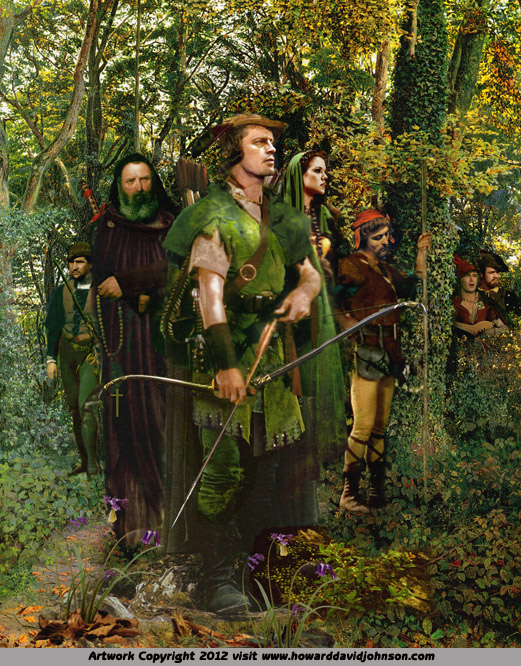
Photography,
Drawing, Painting and digital media combined |
The creation
of Realistic art has been the goal of most artists since the dawn of civilization.
Realistic art was the pride of ancient Greece. The world's greatest museums are full of
realistic art. Realistic art WAS art until the advent of the abstract expressionist
movement in the twentieth century. The coming of the camera in the nineteenth century
changed realistic art forever. Suddenly, realistic art was not the only way to create
realism in portraits and historical records. The work of the realistic artist was suddenly
made into an expensive luxury. The political power of the realistic artist was broken and
they were no longer an indispensable member of society. Hostility to the
creators of realistic art goes back to ancient times and the jealousy of advisers to the
Pharaohs and others who were not able to spend as much time with their rulers as their
portraitists. Although with the aid of photographs, realistic art achieved
levels of excellence undreamed of, the realistic art movement of the late nineteenth
century was short. |
|
None
of these people earning their living creating realistic art could compete with the speed
and low cost of photographic portraiture. Determined to survive, great realistic
artists like Pablo Picasso ingeniously turned inward and began to explore things that could
not be photographed in a new school of art, abstract expressionism. The day of the fine
art superstars had arrived. It was now largely just a hobby to abstract and realistic
artists alike. Illustration, because of advances in printing technology
enabled an elite
few to earn a living with their realistic painting. These illustrators working in
realistic painting media were condemned and ridiculed in much the same way Europe's
great symphonic composers were condemned for working in motion pictures after fleeing the
nazis during World War Two. The rift between realistic and abstract art grew wider and
wider. The universities and key media usually sided with the abstract camp and derided
anyone working in any realistic art media declaring boldly that realistic art was not
"real" art. Immortal giants of realistic art such as Maxfield Parrish were
mistreated their entire lives. They were accused of selling out for creating beautiful
pieces of realistic fine art to earn a living. The attitude that the true artist must
suffer and starve and die in poverty became a rule. There were the Abstract art
superstars, the professional realistic illustrators, and the hobbyists who, although cut
off from gainful employment and social influence still recognized their artistic gifts as
a calling rather than a profession. |
Early abstract art masters proved themselves as realistic
artists before delving into realms of the intangible. They had to do this at that time to
prove themselves because of the challenges they faced from the establishment for going
against the status quo. In the latter part of the 20th century, realistic artists like HDJ
were challenged to do abstract art to prove themselves as shown in the example above
(Deirdre of the sorrows). Later realistic painting training was abandoned in most schools
and things like splattering paint in fits of rage were deemed more than enough. By
the end of the 20th century something as destructive and ridiculous as nailing a pack of
cigarettes to a shoe was considered fine art but not realistic painting. Fashions in art
have often been as silly as fashions in ladies hats. As the century drew to a close,
many people had had enough. The realistic revolt was at hand. The rebirth of realistic
painting was fueled by the advent of the digital era. Now, for the first time in almost
two centuries, an artist or illustrator could earn a decent living again with his
realistic painting. This is historic. Realistic art is not going to go away,
especially
now that photography has truly merged with traditional realistic visual art. Photography
comes from the Greek words meaning "painting with light". Now with the advent of
digital media the capability of realistic art has become almost limitless, truly,
"painting with light". The merger of all the world's art forms to realize the
potential of motion pictures has come now to still realistic art media. This website for
example, combines music, prose, poetry, photography and traditional realistic art media to
create an experience beyond merely looking at realistic paintings.
The twenty- first century is already seeing a new renaissance in the arts
because of the world wide web. There has never been anything like it. Abstract art,
computer art, photographic art, and realistic painting are continuing to be separate
schools of art but are also blending to create exciting new horizons. Although Digital art
does offer completely new horizons to the artist in the 21st century it does not mean the
end of our time honored art traditions. Instead, it offers additional ways to keep these
traditions and schools of thought fresh and alive. ~ HDJ
*****
ABOUT
THE ARTIST
"Those who are enamoured of
practice without science are like a pilot who goes into a ship without rudder or compass
and never has any certainty where he is going. Practice should always be based upon a
sound knowledge of theory, of which perspective is the guide and gateway, and without it
nothing can be done well in any kind of painting."
| Howard David Johnson is a
contemporary visual artist and photographer with a background in |
| the natural sciences and
history. He works in a wide variety of media ranging from traditional |
| oils, pastels and
others to cutting edge digital media. He loves mixing media. This site features
|
| examples of
his Realistic Art, including illustration, photography, experimentalism, and fine
art. |
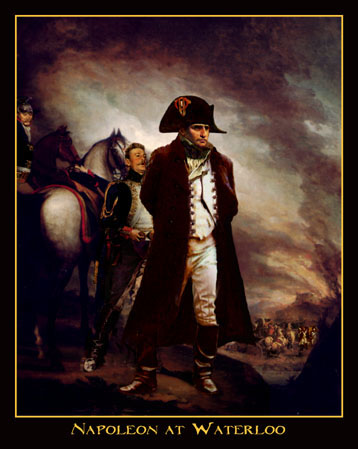
Prismacolor pencils on # 400 Strathmore bristol board |
The various galleries linked to by the icons
above show many examples of His Realistic Art, and are grouped by theme rather than media.
There are also sample illustrations from his upcoming books on Greek, Celtic, and
World Myth & Legend. Since boyhood he has passionately copied the old masters. To
create his work, he usually starts with a thematic concept followed by a rough
realistic pencil sketch, then followed by his photography, often traveling to find
suitable scenes and locations and then working in his Photography studio with live models
from his sketches. He then assembles a variety of elements which are realistic and
original. As a boy he dedicated his life to art in 1960. From 1965- 1999 he used
xeroxes and tracings to make his preliminary photo montages. This is patterned after
the manner used by Maxfield Parrish and other 19th century notables. Beginning with a
tracing, he then draws or paints from these complex original Computer Photo Montages. Many
of these are on display on this web and slated for future completion in a variety of
realistic traditional art media. As this happens, the finished work is substituted in the
exhibit. Recently he shot hundreds of aerial photos of clouds at marvelous angles and
perspectives and also looking down on the mighty mountains, rivers, and deserts of the
American west while flying from Texas to Oregon and back for dynamic source material for
realistic flying scenes in upcoming paintings , drawings, and pictures. |
His favourite medium for realistic painting is colored pencil
because of the high speed and low expense, and people began expressing difficulty in
telling his colored pencil painting from photographs in the early 1980's. In the
last 35 plus years he has also mastered Oils, Pastels, Acrylics, Watercolors, Inks,
Scratchboard, Gouache, Photography, and the highly controversial digital media ( Art
Numérique ) . As a
commercial illustrator Johnson has not only used the computer to create art but has been
involved in the development of computer imaging software. Working in a realistic style
inspired by classic illustrators HDJ is deeply rooted and grounded in the Greco-Roman
artistic tradition, Feeling that with realistic art, the human form is the ultimate arena
for artistic expression. His lifelong dream came true when his Traditional Realistic Art
was exhibited in the British Museum in London England in 1996. His mixed media has also
been displayed in numerous other ones since such as the Metropolitan Museum of Art.
Having already achieved international acclaim as a traditional visual artist he discovered
digital media in 1999. Because of his passion for realistic art and photography he elected
to embrace it and joyfully be a part of this historic era in the visual arts as a 21st
century realistic visual artist. |
Since 1972 when he began his career as a scientific illustrator for the
University of Texas he has earned his living illustrating all kinds of books, magazines,
CD covers, and all sorts of games, greeting cards, calendars, portraits, murals and the
like with his contemporary realistic art... HDJ's Realistic Art has
appeared in every major bookstore chain and fantasy gaming shop in The United States and
has been used in educational texts and magazines all over the world. This site features
realistic painting & pictures for the twenty-first Century including some oil
paintings, as well as lots of other exciting media such as colored pencil drawings,
pastel paintings, acrylic paintings, gouache paintings, watercolor paintings, and pencil
drawings, and also featuring studio, field, & aerial photography, digital
painting and photo-montage and all these media mixed in an assortment of experimental
combinations...Working in a wide variety of media to create his realistic art he offers
his customers a host of payment and product options. He delivers the rights to these
custom made copyright free illustrations and old fashioned customer service when he does
work-for-hire. He loves to paint custom oil paintings and accepts commissions with down
payments starting at one thousand dollars. Other media are less expensive. On his existing
works his low cost license offers start at only 100 dollars.
|

|
Music by
Edvard Grieg
(1843-1907) from"Peer Gynt" Suite no. 1 fourth movement : In
the Hall of the Mountain King
Thank You for Visiting the
Realistic Painting Technique Page of Howard David Johnson...
***** |






























.jpg)




























